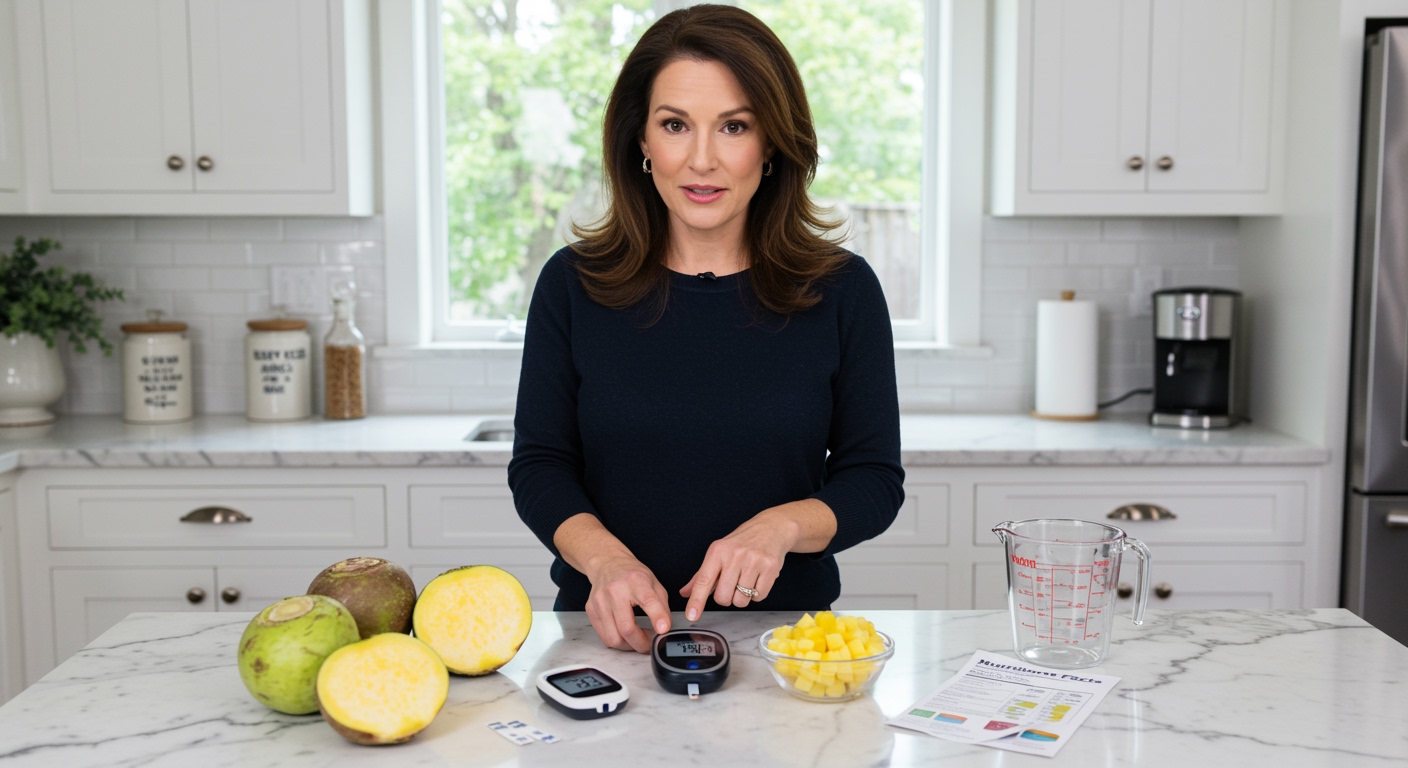✪ Key Takeaway: Rutabaga is excellent for diabetes with a low glycemic index of 35 and only 6 grams of carbs per cup.
Introduction
You walk through the produce section and spot that purple-topped, yellow-bottomed vegetable that looks like a turnip on steroids.
Maybe you are wondering if this strange root vegetable called rutabaga will send your blood sugar through the roof like potatoes do.
Hi, I am Abdur, your nutrition coach and today I am going to explain exactly how rutabaga affects your blood sugar and why it might become your new favorite diabetes-friendly vegetable.
What Makes Rutabaga Different From Other Root Vegetables?
Rutabaga stands apart from other root vegetables because of its unique carbohydrate profile and fiber content.
While a medium potato contains about 37 grams of carbohydrates, one cup of cubed rutabaga contains only 12 grams of total carbohydrates.
The net carbohydrate content drops even lower to just 6 grams per cup when you subtract the 6 grams of fiber.
This high fiber content slows down the digestion process and prevents rapid spikes in blood glucose levels.
The glycemic index of rutabaga sits at a comfortable 35, which places it firmly in the low glycemic category.
Compare this to russet potatoes with a glycemic index of 85, and you can see why rutabaga makes a superior choice for blood sugar management.
✪ Fact: Rutabaga contains 40% more fiber than turnips and 60% more than potatoes.
How Does Rutabaga Affect Your Blood Sugar Response?
Your body processes rutabaga much more gently than most starchy vegetables because of its complex carbohydrate structure.
When you eat rutabaga, the high fiber content forms a gel-like substance in your digestive tract that slows glucose absorption.
This means your pancreas does not need to release large amounts of insulin quickly to handle a sudden glucose surge.
The glycemic load of rutabaga is only 4 per serving, which is considered very low and safe for people managing diabetes.
Research shows that foods with a glycemic load under 10 have minimal impact on blood sugar levels and can be eaten regularly without concern.
Most people with diabetes experience a gradual rise in blood glucose of only 20-30 mg/dL after eating rutabaga, compared to 50-80 mg/dL from the same amount of potato.
✪ Pro Tip: Test your blood sugar 2 hours after eating rutabaga to see your personal response.
What Nutrients Does Rutabaga Provide For Diabetes Management?
Rutabaga delivers several nutrients that specifically support healthy blood sugar levels and overall diabetes management.
One cup provides 53% of your daily vitamin C needs, which helps reduce inflammation and supports better insulin sensitivity.
The potassium content of 554 mg per cup helps regulate blood pressure, which is crucial since diabetes increases cardiovascular risk.
Rutabaga contains magnesium, a mineral that many people with diabetes are deficient in and which plays a key role in glucose metabolism.
The vegetable also provides folate and vitamin B6, which support proper nerve function and may help prevent diabetic neuropathy.
With only 50 calories per cup, rutabaga allows you to feel satisfied without adding excessive calories that could lead to weight gain.
✪ Note: Rutabaga provides more vitamin C than oranges with less sugar impact.
How Should You Prepare Rutabaga For Best Blood Sugar Control?
The way you prepare rutabaga significantly affects its impact on your blood glucose levels.
Roasting or steaming rutabaga maintains its fiber structure better than boiling, which can break down some of the beneficial fiber.
Cut rutabaga into larger chunks rather than small pieces to slow down digestion even further.
Adding healthy fats like olive oil or avocado when eating rutabaga can further reduce its glycemic impact.
Avoid mashing rutabaga into a puree, as this processing increases the surface area and makes the carbohydrates more readily available for absorption.
Eating rutabaga as part of a balanced meal with protein and healthy fats provides the best blood sugar control.
✪ Pro Tip: Pair rutabaga with lean protein to create an even more stable blood sugar response.
Are There Any Concerns With Eating Rutabaga For Diabetes?
Most people with diabetes can enjoy rutabaga without any concerns, but there are a few considerations to keep in mind.
If you take blood-thinning medications, be aware that rutabaga contains vitamin K, which can affect clotting.
People with kidney problems should monitor their potassium intake, as rutabaga provides a significant amount of this mineral.
Some individuals may experience digestive discomfort when first adding rutabaga to their diet due to its high fiber content.
Start with smaller portions and gradually increase to allow your digestive system to adjust.
Always monitor your blood sugar when trying any new food to understand how your body responds individually.
✪ Note: Individual responses can vary, so personal testing remains the gold standard.
The Bottom Line
Rutabaga is an excellent choice for people with diabetes because of its low glycemic index, high fiber content, and valuable nutrients that support blood sugar management.
The best foods for diabetes are often the ones hiding in plain sight, waiting for you to discover their power.
I would love to hear about your experience with rutabaga or any questions you might have about incorporating this nutritious vegetable into your diabetes-friendly meal plan in the comments below.
References
At NutritionCrown, we use quality and credible sources to ensure our content is accurate and trustworthy. Below are the sources referenced in creating this article:
- Signos: Rutabaga Glycemic Index
- January AI: Rutabaga Glycemic Index
- Glycemic Index Net: Rutabaga Fodder Beets
- GetCurex: Rutabaga Glycemic Index Nutrition Facts





